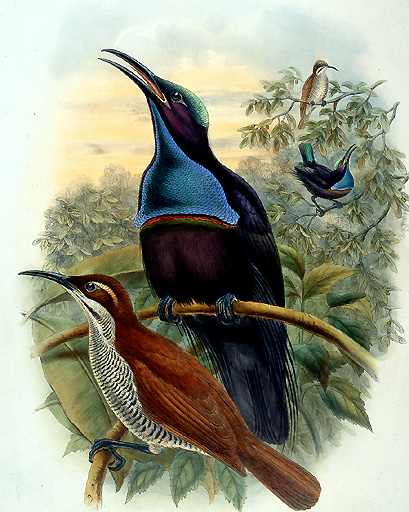
Magnificent Riflebird Ptiloris magnificus (Vieillot)
These birds are found in "Western New Guinea: from Vogelkop eastward in the north to the Sepik River, in the south to the Fly River" (Mayr 1962).
In 1899, Newton (cited in Gilliard 1969) noted that the name 'Riflebird' was "based on its resemblance to the uniforms of riflemen in the British army ... while in its long and projecting hypochondriac plumes and short tail a further likeness might be traced to the hanging pelisse and the jacket formerly worn by the members of these corps." Another possibility for this unusual name is thought to stem from the bird's call, which sounds somewhat like the whine of a bullet.
The Magnificent Riflebird was highly sought after by collectors in the nineteenth century for the millinery trade. At the turn of the century, however, these birds became protected under law and illegal to hunt. Nevertheless, numerous specimens had already been preserved for use as ornaments atop women's hats, while others remained in their original export cartons. Many millinery shop owners were not aware of the identity of the birds and continued to sell them, while others, who learned their identity, packed them away, not wanting to deal in an illegal market.
Although we were unable to locate salmon fly dressings in literature calling for the breast feathers of the Magnificent Riflebird, to the best of our knowledge, the feathers were first used by Charles DeFeo, a well-known New York city commercial artist and innovative fly dresser and designer. In the 1930's and 1940's, Mr. DeFeo used the feathers from the breast of the Magnificent Riflebird for wing cases on his prismatic nymphs and cheeks on wet flies that he tied for the Mirimichi River in New Brunswick, Canada. DeFeo received the 19th century specimens from the curator of the Museum of Natural History in lieu of payment for artistic services rendered to the museum.
If you want to know more about the rifle bird and other birds related to our fly tying heritage, we suggest you order Rare and Unusual Fly Tying Materials: A Natural History.